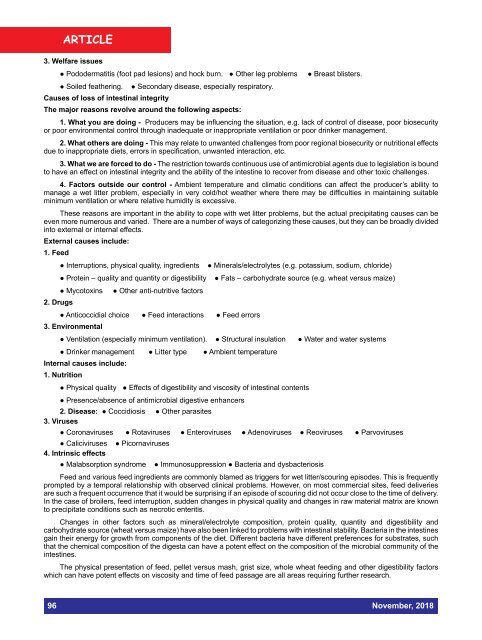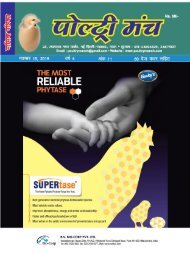November 2018 Punch PDF
Create successful ePaper yourself
Turn your PDF publications into a flip-book with our unique Google optimized e-Paper software.
ARTICLE<br />
3. Welfare issues<br />
● Pododermatitis (foot pad lesions) and hock burn. ● Other leg problems ● Breast blisters.<br />
● Soiled feathering. ● Secondary disease, especially respiratory.<br />
Causes of loss of intestinal integrity<br />
The major reasons revolve around the following aspects:<br />
1. What you are doing - Producers may be influencing the situation, e.g. lack of control of disease, poor biosecurity<br />
or poor environmental control through inadequate or inappropriate ventilation or poor drinker management.<br />
2. What others are doing - This may relate to unwanted challenges from poor regional biosecurity or nutritional effects<br />
due to inappropriate diets, errors in specification, unwanted interaction, etc.<br />
3. What we are forced to do - The restriction towards continuous use of antimicrobial agents due to legislation is bound<br />
to have an effect on intestinal integrity and the ability of the intestine to recover from disease and other toxic challenges.<br />
4. Factors outside our control - Ambient temperature and climatic conditions can affect the producer’s ability to<br />
manage a wet litter problem, especially in very cold/hot weather where there may be difficulties in maintaining suitable<br />
minimum ventilation or where relative humidity is excessive.<br />
These reasons are important in the ability to cope with wet litter problems, but the actual precipitating causes can be<br />
even more numerous and varied. There are a number of ways of categorizing these causes, but they can be broadly divided<br />
into external or internal effects.<br />
External causes include:<br />
1. Feed<br />
● Interruptions, physical quality, ingredients ● Minerals/electrolytes (e.g. potassium, sodium, chloride)<br />
● Protein – quality and quantity or digestibility ● Fats – carbohydrate source (e.g. wheat versus maize)<br />
● Mycotoxins ● Other anti-nutritive factors<br />
2. Drugs<br />
● Anticoccidial choice ● Feed interactions ● Feed errors<br />
3. Environmental<br />
● Ventilation (especially minimum ventilation). ● Structural insulation ● Water and water systems<br />
● Drinker management ● Litter type ● Ambient temperature<br />
Internal causes include:<br />
1. Nutrition<br />
● Physical quality ● Effects of digestibility and viscosity of intestinal contents<br />
● Presence/absence of antimicrobial digestive enhancers<br />
2. Disease: ● Coccidiosis ● Other parasites<br />
3. Viruses<br />
● Coronaviruses ● Rotaviruses ● Enteroviruses ● Adenoviruses ● Reoviruses ● Parvoviruses<br />
● Caliciviruses ● Picornaviruses<br />
4. Intrinsic effects<br />
● Malabsorption syndrome ● Immunosuppression ● Bacteria and dysbacteriosis<br />
Feed and various feed ingredients are commonly blamed as triggers for wet litter/scouring episodes. This is frequently<br />
prompted by a temporal relationship with observed clinical problems. However, on most commercial sites, feed deliveries<br />
are such a frequent occurrence that it would be surprising if an episode of scouring did not occur close to the time of delivery.<br />
In the case of broilers, feed interruption, sudden changes in physical quality and changes in raw material matrix are known<br />
to precipitate conditions such as necrotic enteritis.<br />
Changes in other factors such as mineral/electrolyte composition, protein quality, quantity and digestibility and<br />
carbohydrate source (wheat versus maize) have also been linked to problems with intestinal stability. Bacteria in the intestines<br />
gain their energy for growth from components of the diet. Different bacteria have different preferences for substrates, such<br />
that the chemical composition of the digesta can have a potent effect on the composition of the microbial community of the<br />
intestines.<br />
The physical presentation of feed, pellet versus mash, grist size, whole wheat feeding and other digestibility factors<br />
which can have potent effects on viscosity and time of feed passage are all areas requiring further research.<br />
96 <strong>November</strong>, <strong>2018</strong>





